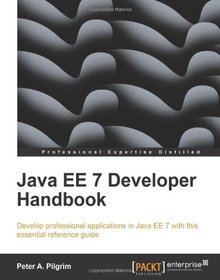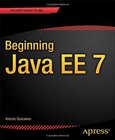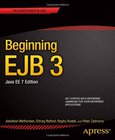Java EE 7 Developer Handbook

Book Details:
| Publisher: | Packt Publishing |
| Series: | Packt , Handbook |
| Author: | Peter A. Pilgrim |
| Edition: | 1 |
| ISBN-10: | 1849687943 |
| ISBN-13: | 9781849687942 |
| Pages: | 634 |
| Published: | Sep 20 2013 |
| Posted: | Nov 19 2014 |
| Language: | English |
| Book format: | |
| Book size: | 7.65 MB |
Book Description:
Develop professional applications in Java EE 7 with this essential reference guide Overview Learn about local and remote service endpoints, containers, architecture, synchronous and asynchronous invocations, and remote communications in a concise reference Understand the architecture of the Java EE platform and then apply the new Java EE 7 enhancements to benefit your own business-critical applications Learn about integration test development on Java EE with Arquillian Framework and the Gradle build system Learn about containerless builds featuring the GlassFish 4.0 embedded application server Master Java EE 7 with this example-based, up-to-date guide with descriptions and explanations In Detail The seventh edition of the Enterprise Java platform is aimed at helping Java engineers take advantage of the advancements in HTML5 and web standards. Web Sockets, asynchronous input and output with Servlets, and strong type safety through the CDI containers will ensure that Java EE 7 remains popular for server-side applications. If you are a user aiming to get acquainted with the Java EE 7 platform, this book is for you. "Java EE 7 Handbook" provides a solid foundation of knowledge for developers to build business applications. Following the lead of Agile practices, there is a focus on writing tests to demonstrate test-driven development principles, using the embedded GlassFish 4.0 container examples and the Gradle build system. You will learn about CDI, EJB, JPA, JMS, MDB, Servlets, WebSocket, JAX-RS, Bean Validation, and so much more. "Java EE 7 Handbook" is designed as a companion to the professional software developer who quickly needs to lookup some working code, understand the basics of the framework, and then go out and fulfill the business contract with the customer. Typically, engineers are under pressure to develop professional code that is of high quality and contains a low number of bugs. Java EE 7 Handbook relies heavily on the Arquillian framework to illustrate how much easier it is to write Java EE tests, and together with the modern practice of writing containerless applications that actually embed an application container, developing agile Java EE suddenly becomes reasonable, smart, pragmatic, and achievable. What you will learn from this book Understand the JSR and the API that are assembled together for Java EE 7 Write server side and client side WebSocket connection in Java Understand the essential differences and similarities between the EJB and CDI containers, as well as dependency injection Learn about Gradle builds, embedded containers, and the Arquillian Framework Build server side endpoints with EJB in stateless, stateful, and singleton modes Write REST server side endpoints on the client and server side Write asynchronous Servlet input and output and also annotated Servlet, Context Listeners Map entities in Java Persistence with the essential cardinalities including the Java side of many-to-many relationships Learn about mapping entities to stored procedures and entity graphs Fully understand how to verify your POJO before they hit the database with Bean Validation API Be prepared for the Java EE 8 journey and beyond, which may include deployment to the cloud
Download Link:
Related Books:
Java EE 7 Recipes
A Problem-Solution Approach
Java EE 7 Recipes takes an example-based approach in showing how to program Enterprise Java applications in many different scenarios.Be it a small-business web application, or an enterprise database application, Java EE 7 Recipes provides effective and proven solutions to accomplish just about any task that you may encounter.You can feel confident using the reliable solutions that are demonstrated in this book in your personal or corporate environment. The solutions in Java EE 7 Recipes are built using the most current Java Enterprise specifications, including EJB 3.2, JSF 2.2, Expression Language 3.0, Servlet 3.1, and JMS 2.0.While older technologies and frameworks exist, it is important to be forward-looking and take advantage of all that the lat...
Beginning Java EE 7
Java Enterprise Edition (Java EE) continues to be one of the leading Java technologies and platforms. Beginning Java EE7 is the first tutorial book on Java EE7. Step by step and easy to follow, this book describes many of the Java EE7 specifications and reference implementations, and shows them in action using practical examples. This definitive book also uses the newest version of GlassFish to deploy and administer the code examples. Written by an expert member of the Java EE specification request and review board in the Java Community Process (JCP), this book contains the best information possible, from an experts perspective on enterprise Java technologies. What youll learn Get started with the latest version of the Java EE Platform. Explore...
Beginning EJB 3
Java EE 7 Edition
Targeted at Java and Java EE developers both with and without prior Enterprise JavaBeans (EJB) experience,Beginning EJB 3, Java EE 7 Editionwill guide you inbuilding enterprise software based on the latest cross-platform industry standards. Learn how to use the EJB 3 API to develop powerful, standards-based backend business logic for creating the complex enterprise applications that run today's transactions and more.With over 20 years of combined EJB experience, the authors offer many practical insights into designing and coding EJB components in combination with related Java EE technologies. EJB has made huge advances in the ease of building enterprise, server-side Java components and business logic development, and has drastically simplified progra...
2007 - 2021 © eBooks-IT.org



